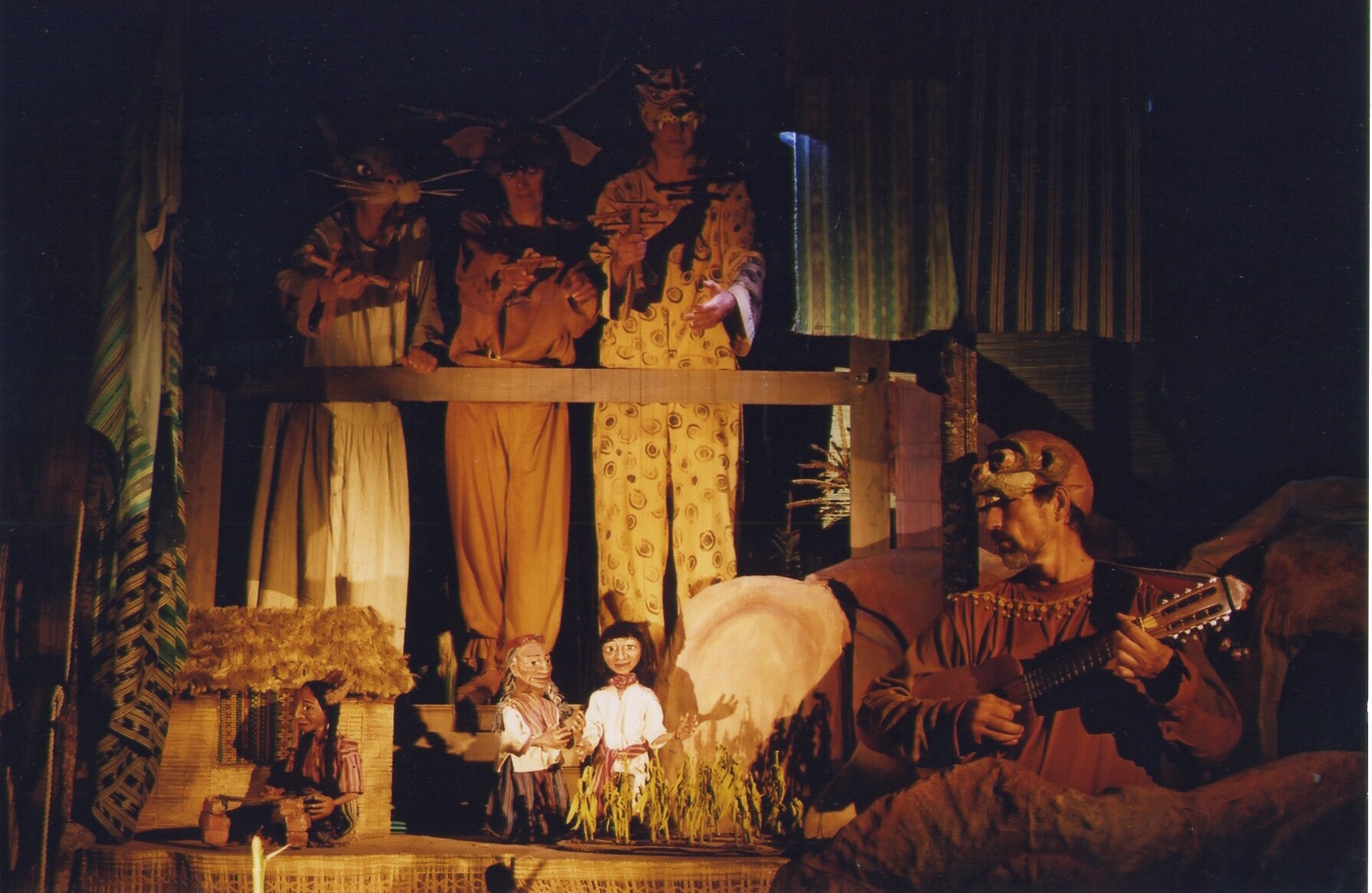In The Time of Miracles (2004)
In the Time of Miracles is a collision of two stories: the journey of a young man to the underworld in search of the sacred seed corn, and a journey of the conquistadors from across the sea in search of gold and adventure.
A play about farmers, set on a working farm. Audience walked through a pathway lined by aisles of tall corn to arrive at the place where the story was to take place, long ago, surrounded by corn.
Poster Design by: Molly March
Marionettes, and Animal Band, and live actors as the historical strangers on horseback.
Planted and presented outdoors at Curly Willow Farm, Grindrod.
Written by Cathy Stubington
Directed by Varrick Grimes
Puppets: Cathy Stubington, Zompopo Flores, Melody
Anderson
Set Design: Phillip Tidd and Molly March
Lighting Design: Stephan Bircher
Performers *Lois Anderson, Kerry Barnhardt,*Peter Hall, Cathy Stubington, Rene Hugo Sanchez
Costumes and Horses: Rick Holloway
Stage Management: Dalynn Kearney
Originally produced at Caravan Farm Theatre in 1992, directed by James F. Tait
*With permission from Canadian Actors Equity Association
Funded by: Canada Council, B.C.Arts Council, Hamber Foundation, Government of British Columbia
Artistic Process
The play was commissioned and originally produced by the Caravan Farm Theatre in 1992. (Most of the same puppets, masks and costumes were used in the Runaway Moon production, and three cast members were the same.) It was sparked by the occasion of the 500th anniversary of the arrival of Columbus, and also the idea that puppet theatre allows for two worlds to exist simultaneously - which Europe and the Americas did, almost entirely, until the arrival of the Conquistadors from Spain began a huge clash of cultures. Puppet theatre’s potential of the use of scale difference as a visualization of power was exciting.
The script was written with background research into accounts of ancient and modern Mayan belief systems - in particular the Popul Vuh (an ancient Book of Counsel of the Quiche Maya), and some annals about the Conquest. A journey to San Cristobal las Casas informed the visual and practical aspects of farming in Central America. Lyrics were inspired by Aztec poetry, and the music took inspiration particularly from a Chilean musical group, Inti-Illimani.
Zompopo Flores, a performer from El Salvador, was a sounding-board throughout the writing and design.
Synopsis
Long ago, according to our understanding of Mayan accounts, we people of the earth could see everything with ease — near and far, past present and future. Tools did our work unassisted, and nature supported us in every way. However, we forgot to thank the gods who created everything and made life easy; to remind us, Heart-of-Sky blew dust in our eyes, and now we can see only see as far as the horizon.
The story follows Possum the farmer, who goes in search of his grandmother’s seed corn which has been stolen overnight. His search leads him through Jaguar’s cave to the underworld, where the corn has been delivered to Lord Seven Macaw. Seven Macaw challenges Possum to the deadly Ball Game, in which it is impossible for anyone to beat him. Just then, three life size actors in golden armour enter, ripping away the curtains that have concealed the inner workings of the marionette world. Possum is rescued from the Ball game only to fall into another impossible fate.
STYLE
The story of Possum and his grandmother, and of the Underworld, unfolded with string puppets, with the manipulators hidden. In between, a band of Animals, or people in Animals masks, inspired by Guatemalan mask tradition, came round to the front of the curtain with theme-related songs,(At the same time allowing for scene changes behind the curtain). Visual elements were inspired by both modern-day Mayan farming and architectural ruins and frescoes from ancient Maya.
At a point in the story, the whole puppet show was interrupted, or invaded, by life-size conquistadors looking for gold. They stripped away the curtain hiding the workings of the set and stuffed most of the puppets into their sacks. This revealed at the same time the Animal Band in an equal scale to the conquistadors, each manipulating a puppet. This reflected our understanding of a belief that humans share the spirit of an animal in the wild.
It is a very true story, and being on farmland in both productions allowed us to grow corn as part of the setting.





























